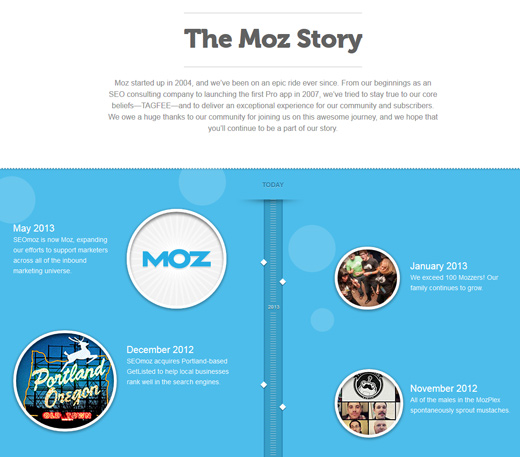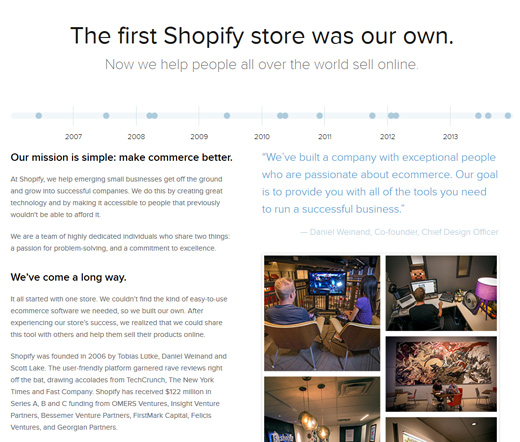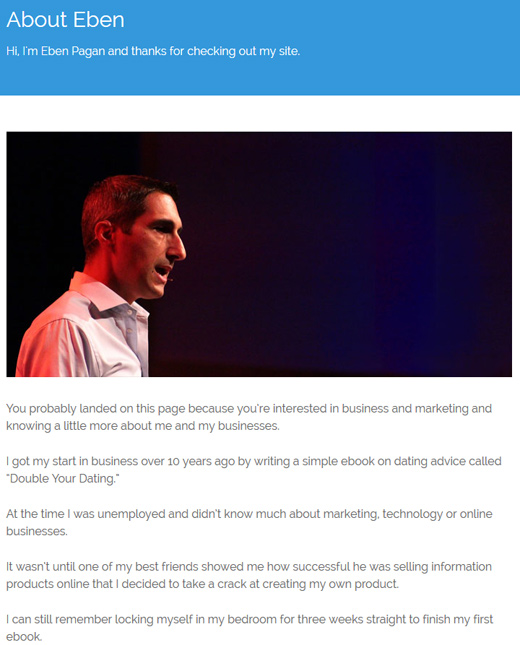
By Felicia Spahr, from The KISSmetrics Marketing Blog – http://bit.ly/1rhXioB
Would you like to know how you can instantly connect and build trust with your audience, no matter what business you’re in?
It has nothing to do with A/B testing a headline. It has nothing to do with setting up a marketing funnel. And, it absolutely has nothing to do with finding the best keywords that connect with your audience.
It’s about telling your story.
When the only thing you think about is selling, selling, selling, what happens? Potential customers get emails that are only promotions. They get bombarded with products to buy, but no useful information. And, they start to feel they are just a number to you, rather than an actual person.
Before you sell anything, you need to connect, and not just with a handshake or sending out one email. You need to emotionally connect with the people you want to be your customers now, and for the rest of their lives.
But how?
Think about it this way. If you were sitting down across from a potential customer at a nice lunch, would you immediately launch into your sales pitch? If you know anything about sales, I hope not! You need to know who they are, you need to know what they want, and you need to prove beyond a reasonable doubt that you understand them.
In order to help you do that, I’m going to walk you through a 3-Step Story Formula that will show you how you can determine, with the precision of a surgeon’s scalpel, what story to tell, exactly how to write it, and what you need to say in order to get a response (like a click, an opt-in, or even a purchase).
STEP 1: Find Your “Origin” Story
Seth Godin recently posted about this, pointing out that an American hero like Superman was raised by two normal parents and that Hewlett-Packard started in a garage. But why? Why should we be talking about humble beginnings?
Because, quite simply, that’s what people can relate to. It’s hard to feel kinship with a company that says, “We make millions of dollars every year.” Think how much easier it is for a customer to trust a company that’s open and honest about how it got started. Walt Disney’s own one-liner on this is an excellent example: “It all started with a dream, and a mouse.”
So, how can you apply this concept to telling your personal story?
As an example, if you look at my personal website, I talk about how I went from being a fiction writer with $6.00 in my PayPal account to actually killing it as a direct-response copywriter (and as a woman, nonetheless). That’s the story I tell because I want to connect with women who are where I used to be. My story is proof that I truly understand them, and that I can help them!
As another example, take a look at a company like SEOmoz and their about page:

This is an excellent depiction of where the company started and how they got to where they are today. You literally can see the company’s trajectory, their successes, and their failures. While, in my opinion, I believe they could tell a more emotionally compelling story, in the adversarial world of SEO, they’ve positioned themselves as a real company that’s for the customer. It’s hard to feel they wouldn’t take care of you.
Shopify also does this well. Look at their subhead: “We’ve come a long way,” and their very first sentence, “It all started with one store.”

That’s very emotionally compelling. We understand we’re not dealing with stuffy suits. We’re dealing with a real company that employs real people and that has struggled just as we all have. Again, they could beef up their “humble beginnings,” but their impressive PR and photos serve as an impressive “after” representation.
So, your first step is to find your “Origin” story that communicates to your customers that you not only “get” them, but you have felt as they do, have acted as they have, and have been in the exact same situation. That’s a radically different approach from just saying, “Hey, we understand you!” which many “me-too” companies do.
STEP 2: Structure It “Hero’s Journey” Style
Back when I was studying screenwriting, one of my professors barked on and on about how important structure was. We would go over our scripts in class and he would interrupt us every second and say: “NO. Structure! There needs to be a structure!”
As annoying as it was, there was a reason he was doing it.
It’s simply not powerful to say, “Hey, I felt really angry about X. And then I did something about it!” People want to know about the work that went on in between. Yet, at the same time, they don’t want you to go on and on about yourself, either. The key is to keep the important elements of your story that directly connect with your audience.
Now, ripping off my former professor’s “3-Arc Story Structure,” a great way to set your “before” and “after” scenes would be to do something like this:
Start with life “As It Was”: Take us to that moment in your life when things were at their absolute worst, the lowest of the low points, and the confusion, the anger, and the frustration. Take us to that moment and tell us WHY you were feeling that way. This is where you immediately connect. People are going to start thinking: “Wow. That’s exactly how I feel RIGHT NOW. What else does this guy have to say?”
Segway into “The Conflict”: When was the moment you knew something needed to be done? (If you’ll notice when you watch a good movie [those that have won Oscars or are critically acclaimed], you’ll see that about 30 minutes in, the main character “begins their journey” because they have realized that if they don’t solve their problem, there are going to be serious consequences.) This is the moment to tell us about, including what you “realized” or “what epiphany you had,” and what you started to do.
End with your “Resolution”: Very simply, this is where you jump to how you solved your problem (the one your customers are having, too). You created your software to help other e-commerce owners have a high-converting check-out page, because you weren’t happy with an 80% cart abandonment rate anymore. Or, you built a 7-figure business, because you mastered online marketing, while, before, you were making pennies. Or, you focused so intently on a craft that you were able to build a career out of it, and now you’re able to teach it to other people.
Eben Pagan’s story is a beautiful example. The online entrepreneur got started with one tiny little ebook and turned his company into a multi-million dollar venture.

Reading his story, it’s easy to feel you can trust him. He’s open, honest, and authentic. And, as a potential customer, you have hope that you can achieve the success he’s had, too.
By the way, these stories don’t have to be particularly long, either. In fact, my friend and master copywriter, Kevin Rogers, teaches you how to use your story and connect with people in just 60 seconds at 60secondsaleshook.com. Your story just needs to let people know that YOU are the one that people MUST trust, rather than the other guy who doesn’t understand them as well as you do. This can be the difference between just talking about tactical information on one subject on a blog for a few years vs. building a business that will last a lifetime.
STEP 3: How to Close
This is one of my favorite parts. Of course, the essence of what I do is get people to take action on something. Therefore, focus only on the kind of marketing that’s going to pull in immediate and direct results for you.
How can you strategically use your story in order to do that?
Here are a few teasers I shamelessly use (because they work) in order to lead someone to click on a link, opt-in to an email list, or even make a purchase. (I’m not talking about CTA button copy here, just phrases that lead someone to your opt-in copy or your button copy after you’ve told your story):
- “Want to know how I did it?”
- “Do you feel the same way, too?”
- “Interested in learning more?”
- “Curious to see other ways we’ve done X?”
- “Want to get access to X?”
You’ll see a lot of these teasers in about pages, at the ends of blog posts, on landing pages, and in emails. If they work on you, steal them! They work because, after reading a story that emotionally connects with us, OF COURSE we want to learn more. Curiosity is one of the single best ways I know to jolt people out of their seats, get them to lean in, and lead them to take action in order to get more of the good stuff.
What You Should Do Today
Telling your story in all your company’s marketing is an excellent way (and a free way, too) to make you stand out, especially in hyper-competitive marketplaces.
Why?
One of my favorite examples of this is from Dan Kennedy’s book, No B.S. Wealth Attraction. He cites a story about High Point University in North Carolina that went from a normal humdrum college to one of the top-ranked colleges in the U.S. funded by $300 million in investments. (Universities are businesses, too).
The best part about it was the school began to tell its story – in all its marketing – and that got OTHER people to talk about the story, which was what led to so much interest, increased applications, and donations. Obviously, there are a lot of systems in place to allow this to happen, but this concept is yours for the taking: Tell your story well, so your best customers can tell it, too. (Tweet that!)
The reason this works is because no one else has your story. No one has your unique perspective. No one went through the exact thing you went through, in the exact way you did! Your story can pull the people you want to attract to your business together and make them say “Yes” and immediately forget about everyone else.
So, use your story on your company’s about page, in your emails, in your brochures, in any direct mail you send out, and at events where you are speaking. The rule is: “Everywhere you are, your story should be, too.”
Not only will people remember you for being truly different, but the right people will be your customers for life.
